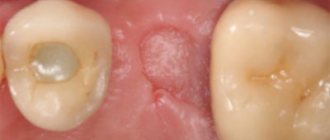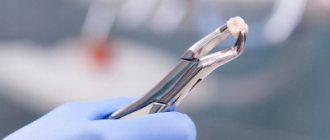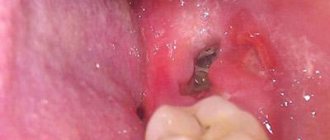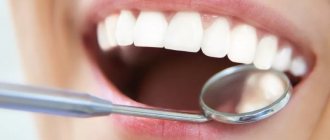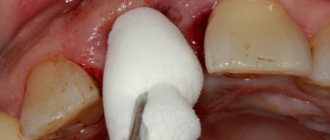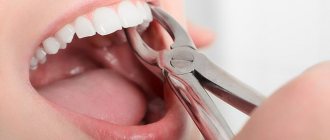How long does it take for gums to heal after tooth extraction?
Tooth extraction can be emergency or planned, but in each case healing occurs the same way.
Extraction of the organ is carried out when it is not possible to preserve the crown, in case of severe inflammation, or in advanced periodontal disease. The operation is performed under anesthesia, so there is no pain during removal. Unpleasant symptoms appear after the end of the dentist’s visit. The gums in the area of the removed organ hurt, but normally this goes away after seven days.
When the gums still hurt seven days after the tooth extraction is completed, and the inflammation does not subside for a long time, this indicates a complication. The most common consequences of organ extraction are alveolitis, bleeding, fracture, and injury to the socket.
Self-medication during recovery as a source of the problem
Often patients do not ask the doctor what to do if they have pain. They begin to actively rinse the inflamed area, apply compresses to the injured area, and warm the cheek with a heating pad. All these actions are prohibited unless prescribed by a specialist.
Normally, a dense blood clot should form after surgery. It is an essential element of the healing process, as it covers the wound surface from pathogenic microorganisms. If you constantly rinse your mouth, the clot will not form or will resolve prematurely. Then damaged tissues will remain unprotected from infections and bacteria.
If you heat the area of inflammation, the swelling may increase. Applying compresses directly to mucous membranes often leads to a chemical burn. Therefore, if your gums hurt after tooth extraction, it is not advisable to experiment. The most reasonable thing is to visit a dentist and consult with him.
How many days does it take for the socket and gums to heal?
During a complex operation, the dentist may damage the jaw or push the tooth root into the maxillary sinus. If you do not seek help from a dentist for a long time with such complications, even more terrible conditions appear - gumboil, cyst, osteomyelitis.
Complete healing of the gums after tooth extraction occurs within several weeks. All this time, the mucous membrane hurts a little, but is simply anesthetized with local drugs.
The healing time of the hole is personal for each patient. Recovery takes a long time if care recommendations are not followed. The gums after tooth extraction do not heal even after a couple of weeks, if an infection was introduced during the operation or after the end.
The gum heals in 14 days, and complete restoration of the socket occurs in six months.
Here are some recommendations after tooth extraction:
- Do not warm your cheek.
- Do not rinse with anything, contrary to popular belief. DO NOT RINSE. Thus, the formed blood clot is washed away and the wound opens, into which infection from the oral cavity enters.
- Do not lie down for the next hour so that the blood does not rush to your head.
- Do not lift anything heavy so that the blood does not rush to your head.
- Don't get too cold.
- No smoking.
- Don't drink alcohol.
But the most important thing in extracting a tooth is not to let it go to waste. Take care of your teeth, because a tooth is an organ like many others in our body, but it is the only one that cannot be regenerated, that is, restored. And an organ, if it is sick, needs to be treated. Although there are a lot of teeth, they eventually run out.
Why does the hole take a long time to heal?
Epithelization of the gums after the operation begins after a couple of days, and a white coating appears on it. Now it doesn’t hurt so much anymore, and there are no signs of inflammation. At this time, it is better not to touch the mucous membrane, but just continue to properly take care of the hole. It may not heal for a long time due to the patient’s personal quirks, at a time when there are diseases of the circulatory system or chronic inflammatory processes in the body.
If your gums hurt very badly after seven days, this is possible:
- Dry socket or alveolitis - this complication often appears when the rules for organ removal are not followed, while part of the crown or root remains in the socket. Under such conditions, the blood clot, which should protect against infection, falls out. This complication much more often begins on the 5th day after the end of the operation. Common symptoms are gum discoloration, unpleasant odor, halitosis, soreness, slight bleeding;
- Chronic bleeding - this complication is observed in people with hypertension and in the case of blood diseases. This may result in alveolitis. Before sending the patient home, the dentist stops the bleeding and places a hemostatic sponge on the hole;
- A fracture or dislocation of the lower jaw is a rare complication that occurs more often during the removal of a wisdom tooth; the risk increases if there is a cystic formation or acute inflammatory process in the root area;
- Perforation of the maxillary sinus is possible as a result of complex removal of chewing teeth in the upper jaw.
If the hole hurts for a long time, and it does not go away after seven days, you should immediately consult a doctor. It is forbidden to cope with complications that appeared during the removal on your own. Apart from this, there is no way to prevent them, so first aid is provided immediately after the procedure is completed.
Complications due to improper care, which slow down gum healing, can be prevented on your own.
Why does the tooth socket heal poorly?
The process of formation of new tissues may be accompanied by sensations that signal the development of pathologies. The following points indicate improper healing of the hole:
- If the blood continues to flow for 3 hours;
- Acute pain and intense swelling of the healing area;
- Pus and an unpleasant odor form in the hole;
- High fever, headache and enlarged lymph nodes.
Another sign of severe inflammation is increasing swelling of the cheeks and gums. To relieve pain, you should make a cold compress and apply it to the area of swelling. When the swelling covers a large area, moving to the neck, you should immediately visit the dentist or call a doctor at home. Such a symptom indicates an actively developing infectious infection.
Alveolitis is an inflammatory process in the socket after tooth extraction. This is a serious problem and requires prompt intervention by a dentist. The reasons for the complication are not only the incorrectness of the operation, but also non-compliance with recommendations for oral hygiene and care for damaged gums.
There is no home treatment for alveolitis, as it requires opening the socket by a professional dental surgeon. The treatment process begins with cleaning the hole from the blood clot and rinsing with antiseptic agents. Next, the doctor will order examinations to monitor the condition of the gums and place anti-inflammatory medications in the socket of the extracted tooth. As soon as the symptoms of inflammation subside, special agents are placed in the wound to speed up the healing and restoration of the hole.
What to do after the extraction is complete
It is possible to realize that the hole is healing correctly on the 3rd day. The gums hurt moderately, and a white coating appears on it. It is extremely important not to remove it, since it is new epithelium. After 2 weeks, the onion should be completely covered with granulation tissue. After a month, bone tissue begins to regenerate in the entire socket. After 50 days, bone tissue fills the entire hole. And only after five to six months the hole is completely healed and does not differ from other bone tissue.
The gums will recover faster after tooth extraction is completed if you follow easy recommendations.
In the first days after surgery, minor bleeding may occur. Under such conditions, you need to take a small piece of cotton wool or gauze, soak it in hydrogen peroxide, and apply it to the hole. It is much better to go to the pharmacy immediately after removal and buy a hemostatic sponge. A small piece must be applied to the hole; it will dissolve on its own.
When you urgently need medical help
The reason to visit the dentist again is intense throbbing pain after extraction, swelling of the cheek, and the appearance of a specific (unpleasant) odor from the mouth. All these symptoms indicate the development of inflammation, which requires immediate correction. You should also not postpone your visit to the dental clinic if:
- strong painful pulsation persists for more than two days;
- accumulations of purulent masses appeared;
- pain radiates to the ear, chin, temporal area, bridge of the nose, forehead;
- the cheek is very swollen, it is impossible to touch it, since tactile contact increases the pain;
- body temperature has increased and remains high for more than one day;
- there is no blood clot on the alveolus, which should form in the next few hours after extraction;
- weakness appeared, performance after the operation decreased sharply, and the situation did not improve even a few days after the dental intervention.
You must not allow the infection to spread in your mouth. Attentive attention to your own well-being is the key to successful rehabilitation and rapid healing of the wound surface. By following the doctor’s prescriptions, you can greatly increase the chances of successful rehabilitation after extraction of a molar.
Do not rinse your mouth for the first 24 hours.
It is necessary to avoid warm foods and drinks, and not to take alcohol or blood thinners. It is possible to numb the wound with drugs such as Nimesil, Ibuprofen, Paracetamol. While brushing your teeth, you must avoid moving the bristles near the removed organ. If bleeding starts unexpectedly after a couple of days, you should immediately go to the doctor. This also applies to those cases when the pain is not relieved by simple analgesic and anti-inflammatory drugs.
On the third day, it is already possible to start rinsing the oral cavity with warm antiseptic solutions and herbal decoctions. This will speed up the healing of the hole and prevent inflammation and infection of the wound. For a couple more days you need to refrain from heat, sports, saunas, baths.
Some medications can have the opposite effect, leading to bleeding, so the medication must be coordinated with the dentist. Before removing the doctor, it is imperative to give a warning about concomitant and previous diseases. Tooth extraction has contraindications, and if they are missed, complications cannot be avoided.
When to see a dentist
A visit to the doctor should not be delayed in the following cases:
- Initially or after a couple of days, a blood clot falls out;
- A purulent lump appears in the area of the hole;
- The pain does not go away for a long time and inflammation appears;
- The entire jaw begins to ache, radiating to the temple and eye areas;
- There is a constant iron taste of blood in the mouth;
- Pain appears in the area of the adjacent tooth;
- Within 5 days the gums are not covered with white plaque.
If you are worried about your teeth, you will be helped at the Doctor-RAF Dental Clinic (Almaty, Muratbayev St., 101). Our highly qualified specialists will help you solve all your dental problems.
During the operation, a neighboring organ may be damaged. This will manifest itself as symptoms of pain, and perhaps the tooth will begin to loosen.
Complex removal will require additional care and the use of bactericidal drugs, but only those prescribed by the dentist. Self-prescribing antibiotics is prohibited. An exception would be local gels and ointments, which are available without a prescription and have an anti-inflammatory effect.
8 reasons why the hole does not heal after tooth extraction, ways to speed it up.
After tooth extraction, it seems that the worst is over. However, this is a surgical operation that does not exclude the possibility of complications, especially if you do not follow the doctor’s recommendations. What to do when the hole does not heal?
Content:
- How does the regeneration process proceed after extraction of the “eight”
- When will the hole heal?
- The main stages of socket healing after wisdom tooth removal
- What determines the speed of regeneration?
Oral care after wisdom tooth removal includes many nuances.
They all pursue one common goal - to prevent infection from entering an unhealed wound, and for regenerative processes to proceed quickly. The dentist tells the patient in detail how to care for a deep hole in the gum, but not all patients listen carefully. Some people deliberately ignore the specialist’s appointments, but in vain. Indeed, with proper wound care, many complications can be avoided.
Healing process
The stages of wound healing are as follows:
- The first day: the hole fills with blood, which turns into a clot due to coagulation. It becomes the basis for bone formation in place of the void, and also protects against infection.
- 3-4 days: the clot is replaced by granulation tissue. By this time, the severity of pain decreases, and sometimes the area of surgery stops hurting completely.
- Week: a clot remains inside the socket, but most of it has already been replaced by granulation tissue.
- Two weeks: the wound is filled with granulation tissue, turning into bone along the edges and bottom.
- 2-3 months: the hole completely turns into bone.
In order for recovery to occur correctly, you must follow all the doctor’s recommendations.
Why doesn't the hole heal?
The timing of wound healing is an individual question. It is determined by several factors - the traumatic nature of the removal, the presence of postoperative sutures, and the age of the patient. It is believed that partial epithelization takes about 2 weeks, complete - up to two months. These deadlines may increase for the following reasons:
- The bone was severely damaged. This happens, for example, during a complex extraction, when the tissue around the tooth has to be cut out with a drill.
- The clot has fallen out, so there is no basis for the formation of granulation tissue.
- Due to the doctor's fault, bone fragments remained in the wound.
- The patient ignores the recommendations received. The most common mistake is rinsing out the clot, after which an infection from the oral cavity gets into the wound.
- The mucous membrane around the wound is mobile, and no stitches were applied.
- Carious remains entered the cavity and inflammation began.
- The surgeon did not take into account individual characteristics. For example, with arterial hypertension, heavy bleeding begins, so drugs that lower blood pressure are additionally prescribed.
- Old age of the patient.
Ways to speed up healing
The best thing a patient can do to speed up epithelialization is to create conditions in the oral cavity that are close to sterile. To do this, you must follow some rules:
- Squeeze the cotton swab applied after surgery tightly with your teeth for 15-20 minutes.
- Do not eat for 3 hours so as not to interfere with the clot formation process.
- In the first days, do not smoke, give up alcohol and solid food.
- Avoid heavy physical activity, temperature effects (hot drinks and dishes, trips to the bathhouse, sauna).
- Do not chew on the injured side for two days.
- Avoid rinsing and use chlorhexidine baths instead.
- Take prescribed medications - for example, antibiotics, which are prescribed after a complex removal, in the presence of purulent processes.
- After consulting with your doctor, use Solcoseryl, a gel that helps accelerate epithelization.
It is important to remember that the area where the deletion took place is a very vulnerable place. The mouth is home to a large number of opportunistic microorganisms, which, in the presence of a source of bleeding, become pathogenic, triggering the inflammatory process. To perform the operation, you should choose an experienced surgeon and strictly follow his recommendations after the procedure.
What affects the speed of healing of the hole after tooth extraction?
It is necessary to follow the rules for caring for the hole of an extracted tooth, which will help the gums recover much faster. Immediately after the tooth extraction procedure you should:
- It is good to clamp the gauze swab with your teeth, placed by the dentist on the hole after removal. It is the pressure on the edges of the wound that is important, and not the time, although the average holding period is regulated and is 15-20 minutes.
- You can eat food only 3 hours after removal, and it is advisable not to drink, so as not to harm the process of formation of a blood clot in the hole.
- It is forbidden to smoke and drink alcoholic beverages, as well as eat spicy, hot and solid foods in the first days after removal. This reduces the risk of damage to the “blood plug”, due to which the hole can avoid repeated bleeding and purulent inflammation.
- You cannot engage in heavy physical labor, sports, go to the bathhouse, sauna, sunbathe and overheat for several days (for the same reasons).
- For two days, you should protect the side of the jaw from stress: do not chew or sleep on the part where the tooth was pulled out.
The hole heals slowly if the extracted tooth was inflamed. The gums will also heal. There is a risk of inflammation of the socket due to improper wound cleaning. During surgery, not all tooth fragments can be removed, which will become an obstacle to healthy gum healing
